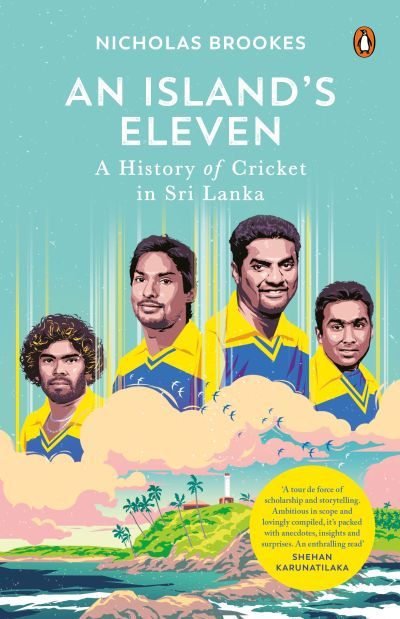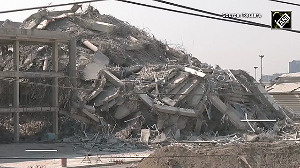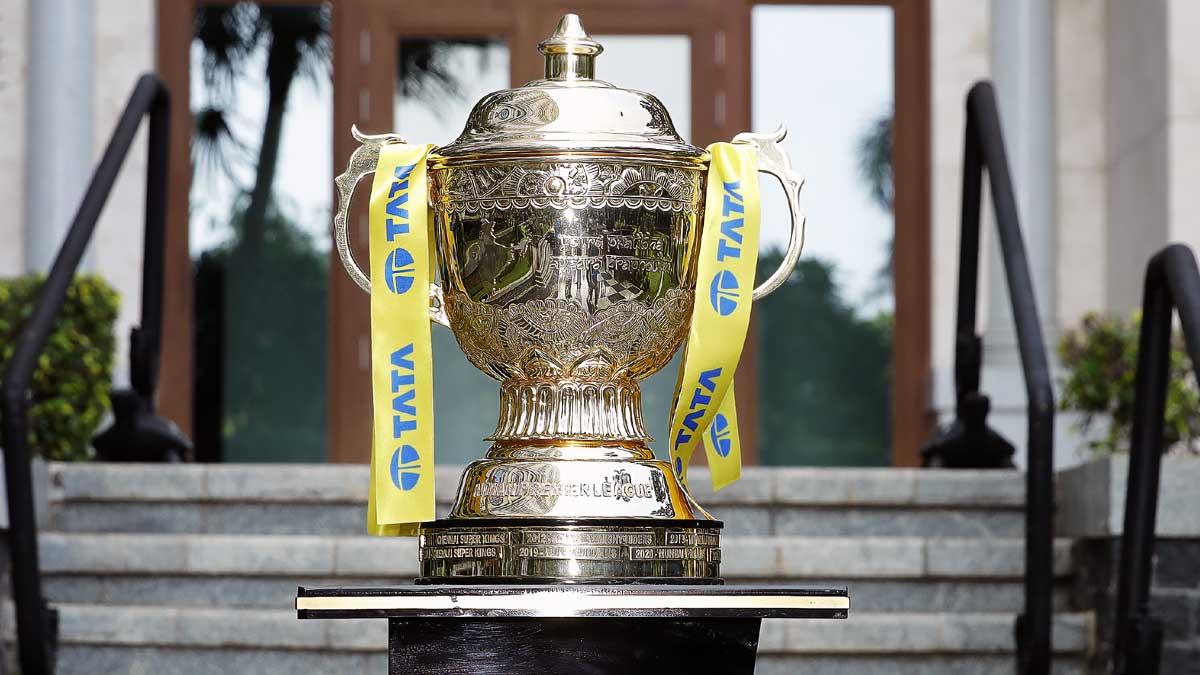The team heard a loud crackle. Then the scream came from Dilshan at the front of the bus. 'Get down.'
Jayawardene was hit first; his sock filled with blood.
Outside, twelve gunmen blocked the exit.
A revealing excerpt from Nicholas Brookes's An Island's Eleven: A History of Cricket in Sri Lanka.

In the last days of his tenure, Arjuna Ranatunga offered his team up to tour Pakistan in 2009.
It was a surprise: With the country's security situation worsening, most were running for the hills.
Arjuna was singing from a different hymn sheet: conscious of the two countries' historic relationship, and Sri Lanka's own former status as cricketing outcast, he announced that the island had a duty 'to help Pakistan when it is needed most.'
Though the players had serious concerns, they agreed once the PCB promised 'head of State' security.
While Ranatunga's sacking briefly threw the trip into doubt, Sri Lankan Cricket's dwindling finances meant the team had to play all the cricket they could.
So Mahela Jayewardane's men faced a dizzying, relentless schedule, starting with three ODIs in Pakistan.
Those passed without incident; inside the rope, it was a breakout trip for Tillakaratne Dilshan, finally starting to fulfil his long-latent potential.
Despite his obvious promise, he had made just six international hundreds during his first decade in international cricket.
From the start of 2009, he made 33 -- his averages leaping as a shift to the top saw him develop into a real focal point for this Sri Lanka side.
Jayawardene points to a conversation in 2007.
'We had an honest chat when he was left out of the team,' he recalled.
'He was the first to come and say, "I need to bat higher up the order." So I said, "Can you open the batting?'"
Over the next year, Dilshan opened for Bloomfield in white-ball cricket -- after his excellent showing during the Tests in Bangladesh, Bayliss and Mahela decided it was time to give him a go atop the Sri Lanka order.
With 42 (off 33), 76 and 137*, he instantly made the opener's berth his own.
Though Dilshan was less effective as the team struggled against India, a workman-like 97 in the last match ensured Sri Lanka staved off a 5-0 defeat.
Still it was a disheartening ten days, with both bowling and batting a step behind Dhoni's men.
The Indians had clearly done plenty of video analysis of Ajantha Mendis too: he leaked 199 runs in 39 overs, claiming just 5 wickets in the process.
The biggest shock of all was Jayawardene's announcement that the Pakistan tour would be his last as captain.
'It was way too much for me to manage my cricket being the captain,' he told me.
'Trying to make all those decisions off the field. It was way too much.'
Over the past year, he had fought tooth and nail to secure better pay for the juniors, and seen his name tarnished over the IPL affair.
Marvin Atapattu had stopped talking to him, and his relationship with Sanath Jayasuriya had soured too. All of this took a toll; at 31, Jayawardene no longer needed the hassle.
It is a great shame that leading Sri Lanka had become such a thankless task--by now, it required such sacrifice that none wanted to stay more than a couple of years.
Had Jayawardene come from any other country, he would have enjoyed a far longer run. But in Sri Lanka, it was untenable.

Though his captaincy deserved a fairy-tale ending, it came crashing to a close with the most harrowing of nightmares.
The Pakistan series had been stifled by lifeless pitches: After seven days' cricket, it was dragging towards a 0-0 draw.
Nothing was out of the ordinary as the team left for the ground on the third morning of the Lahore Test.
The players sat in their usual seats; one of the quicks grumbled about what hard work the tour had been.
'Maybe something will happen and we can all go home,' he joked.
Moments later, the team heard a loud crackle. Then the scream came from Dilshan at the front of the bus. 'Get down.'
Within seconds the bus was at a standstill, being torn into by a torrent of bullets. Jayawardene was hit first; his sock filled with blood.
Mendis was struck down with a shrapnel wound, Paul Farbrace saw a piece of metal lodge in his arm.
Blood soaked through every inch of Tharanga Paranavitana's shirt; Thilan Samaraweera cried out as a bullet pierced his thigh.
Kumar Sangakkara raised his head and saw a bullet lodge in the spot where it had been a moment earlier. With the bus stationary, those inside were like fish in a barrel.
Outside, twelve gunmen blocked the exit to Liberty Roundabout. They had shot down the police escort -- uncowed by return fire, the assault wore on and on.

It is a miracle that none of the team were killed. Murali remembers the chaos around him unfolding in slow motion -- blood gushing from Farbrace and Samaraweera's wounds, Prasanna Jayawardene immersed in prayer.
After what felt like minutes, Dilshan stuck his head above the parapet, and began shouting directions at the driver Mohammad Khalil.
Crouched under the steering wheel, Khalil managed to get the bus moving, and with Dilshan's help, got off Liberty Roundabout.
On flat tyres they hurtled the half-kilometre to the ground, crashing through the gates of the Gaddafi Stadium.

While the team feared the worst for Paranavitana, Samaraweera could not walk and had to be carried from the bus.
Both were bundled into an ambulance and taken to the nearest hospital; in the changing room, the rest could hear the relentless rattle of gunfire in the distance. They had been lucky.
The 'head of State' security PCB Chairman Ijaz Butt promised was sorely lacking.
Police should have been stationed at the roundabout; since they weren't, the team's attackers faced no backlash until forces arrived from the ground.
Khalil saw a man throw a grenade at the bus; though it rolled under the chassis, the pin hadn't been properly pulled.
Just as he got them moving, a rocket-propelled grenade flew past, smashing an electricity pylon.

Khalil drove the team to safety after terrorists attacked the bus on March 3, 2009 near the Gaddafi stadium in Lahore. Photograph: Buddhika Weerasinghe/Reuters
Still, they were not in the clear. The team had to move, but Mahela refused to get back on the road.
Instead, a military helicopter was arranged to take them to the airport.
After an emotional farewell with Khalil, the team boarded the chopper.
For Murali and Chaminda Vaas, a charter out of Lahore dug up incongruous memories.
Back in March '96, they'd fled the city in the small hours with cricket's most coveted trophy; thirteen years later, they were lucky to escape with their lives.
There was cruel irony in the fact that the architect of that triumph's fingerprints were smeared across this tragedy.
Arjuna had to ask himself whether he properly considered the consequences before sending his team into such a volatile situation.
That said, any failure on SLC's part paled in comparison to the PCB's shocking negligence.

Chris Broad (the ICC referee, who was also on the bus) told The Independent that the convoy were left as 'sitting ducks'; while all accepted the tragedy could have been much worse, six policemen and the umpires' driver lost their lives.
Their death was a sobering shock; as Farbrace later put it, 'It just shouldn't have happened, that people died trying to help us get to a match... That sadness I think will stay with me forever.'
The horror would not easily subside. Still, it was a mercy that every member of the Sri Lanka squad would return to the cricket field, sooner rather than later.
Sanga joked that Paranavitana must have endured the worst debut tour in history -- he'd bagged a duck in his first innings, been run out in his second and then taken a bullet to the chest to top it all off.
But he was incredibly lucky that the shrapnel lodged in his sternum -- an inch either side and he likely would have been killed.

Samaraweera had a real stroke of luck too. With doctors reluctant to carry out a second, potentially career-threatening surgery, the President (Mahinda Rajapakse) offered up the services of his personal Ayurvedic doctor, Eliyantha White.
The surgeons allowed him eighteen hours to work on Samaraweera's wound; remarkably, by the time they removed the bandage, it had begun to heal.
Sri Lanka's next assignment was the World T20 in early June. Sangakkara was announced as the team's new captain: his and Mahela's shared understanding meant the philosophy would shift little moving forward.
'We've always had a very strong leadership group,' he told me.
'Whether you were the nominated captain or not, we were all pretty adamant that everyone should be part of that, buy into the fact that this is our strategy and everyone has equal and valuable input. I'd been a part of that leadership group for a few years, so taking the reins was not that overwhelming. I wasn't overawed by it.'

Though it was eerie getting back on the team bus for the first time, Sri Lanka refused to wallow. 'We didn't make a big deal about things,' Sangakkara explained.
'There was no song and dance about it. It was just about getting back to cricket, doing what we loved and what we did best. That's how we approached the T20 World Cup. There was no greater significance in terms of the fact that we had just gone through a horrific experience. It was just a World Cup. Fantastic. Let's go and have a great time playing it.'
Excerpted from An Island's Eleven: A History of Cricket in Sri Lanka, by Nicholas Brookes, with the kind permission of the publishers, Penguin Viking India.
Feature Presentation: Aslam Hunani/Rediff.com







 © 2025
© 2025